| Mass Times Saturday at 4:00 p.m. Sunday at 7:30, 9:00, and 11:00 a.m. Monday-Friday at 8:15 a.m. |
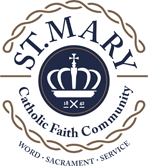 |
9520 W. Forest Home Avenue Hales Corners, Wisconsin 53130 414-425-2174 Contact Us |
St. Mary History - The 1900's
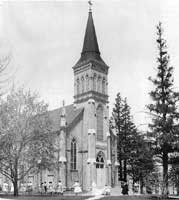 For 67 years, Catholics in the Hales Corners area were baptized, married, and buried from the "brick church on the hill." |
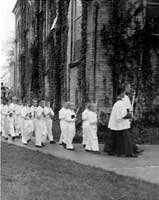 First Communicants filed into the old church in this undated photo. |
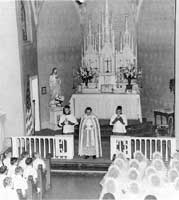 Father Trahey welcomed First Communicants during a mass in the "brick church." |
1930-1942
Hales Corners and St. Mary experienced slow but steady growth in the 1930s. No doubt the regular spiritual benefits helped the people endure the material hardships of this time. Father Gormley's health failed in 1940, at which time he was relieved as pastor.
Father Gormley was succeeded as pastor by Father David W. Ryan in 1940. In 1942, Father Ryan entered the United States Army and was succeeded by Father Joseph T. McQuestion.
1952-1962
By 1952, the number of families had increased to 288, with more than 200 children of grade-school age. Many children of the parish attended the St. Alphonsus School at Greendale through the invitation of the pastor, Father Arnold Spangler. Father McQuestion, foreseeing the growth of his parish, inaugurated a fundraising drive to build a school. The drive met its goal of $150,000 in pledges, and in February 1953 a contract was let to the Schmidt Construction Company for a building with eight classrooms, a kitchen and a hall.
Father McQuestion's death in July caused Father George Hastrich, the assistant of the parish, to take charge of the school's completion until the new pastor, Father Thomas P. Trahey, arrived in August. On July 11, just four days before Father McQuestion's death, men of the parish, several of them professional builders, began construction of a convent so that the teaching nuns could be assured of living quarters when the school opened. The School Sisters of St. Francis were on hand when the building held its first classes on September 8, 1954. There were 17 pupils in the first graduating class of 1955.
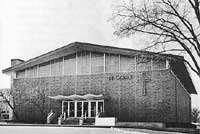 The new St. Mary's church, circa 1961, shortly after completion. |
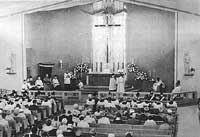 Dedication ceremonies by Archbishop Cousins on May 9th, 1961 |
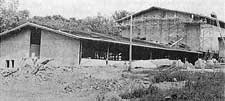 The addition during construction |
By 1959, community growth within the parish boundaries had brought the parish to 800 families, and both church and school were proving inadequate. Catholic families were attracted to the area by the excellent school facilities, and farms were being plotted and lots sold at a remarkable pace. Soon the capacity of the school had been exceeded, with more than 425 children enrolled. Even with 10 classrooms (two more had been set up in the basement hall), more than 300 children were turned away in 1959. It was time for expansion and Father Trahey directed a new fund drive to garner pledges to finance an addition to the school, and for a new church auditorium, which could accommodate the growing number of persons at all Sunday masses. The drive was successful and soon a contract was let to Math Starck and Sons for construction of a combination of 10 classrooms and a new church at a cost of over $400,000. The schoolrooms were in use by September 1960. The first service in the new church was a Midnight Mass celebrated by Father Trahey on Christmas 1960.
In December 1962, Father Trahey resigned because of ill health and was succeeded by Father Francis Drabinowicz, who arrived on Christmas Eve. An accomplished pianist and former director of the Bel Canto choir, a well-known choral group, Father Drabinowicz was often called upon to play for the enjoyment of St. Mary's organizations.
1963-1965
In 1963, the parish witnessed the demolition of the "Church on the Hill," which had served St. Mary for so long. It had been built to serve a much smaller parish and its lack of facilities forced a reluctant decision to raze it. To many parishioners, its passing marked the end of an era. To those who arrived in later years, it represented a link with a simpler past. Many parish families treasured some small souvenirs from this building -- a bell rope, a brick or two, a piece of stained glass.
A liturgical era was also at an end as a result of the Second Vatican Council. Changes in worship required the redesign of the church sanctuary and the installation of a new altar in 1965.
1969-1970s
In March of 1969, Father Drabinowicz was replaced as pastor by Father Francis Tenpenny. His service at St. Mary was extremely brief as cancer claimed him in July. Monsignor James Doheny became an interim pastor until the appointment of Father George Zwadzich in 1970.
Father Zwadzich presided over the formation of the Parish Council, which enabled the lay people of the parish to assume some of the burdens and duties of St. Mary, which now included over 1700 families. Overcrowding at Sunday Masses in the mid-70s made it necessary to plan another addition to the church. The planners sought to create a warm and inviting setting for the liturgy through a large narthex or fellowship area. Access for the handicapped was also provided.
The construction of the new wing began first. Upon completion, this multi-purpose room functioned as a gymnasium, meeting room and most importantly, as a place to worship on weekends while church renovation continued. One of two new classrooms included in this wing was used as a chapel for weekday liturgies. A tower and carillon system, donated by the Altar Society, was also built to house the bell from the "Old Brick Church."
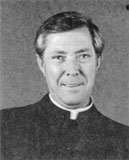 Rev. Leonard Barbian 1982 - 1993 |
1982-1984
Father Zwadzich's poor health and retirement led to the appointment of Father Leonard Barbian as pastor of St. Mary in 1982.
The decrease in the number of vocations to the sisterhood and the changing role of nuns led to the closing of the parish convent. In winter of 1980-81, the convent was remodeled into a parish office, in which the individual bedrooms were made into offices, and the front chapel was made into the main office. Several years later, a recreation room was built in the basement, so that it could be an additional meeting room, a much needed space for this growing, active parish.
About the time when the convent closed, the parish purchased a white house one block away from the school on Allenwood Lane to be the new residence for the sisters. However, because of declining vocations and other factors, the Sisters of St. Francis decided to no longer staff the parish school. The remaining sisters then moved to private apartments. In the end, the white house was used only by Father Ron Gramza, then Sister Phyllis Wirtz; and in 1984, the parish sold the house.
Some of the proceeds from the sale of the white house went to finance the rectory remodeling project, which occurred in 1984. Fresh carpet was laid down, a large bay window was installed, and new furnishings were added. giving the rectory a charm and spaciousness it had lacked.
1989
Another significant improvement to the parish grounds was the creative playground, located on the small lot just south of the parish office. This kids' entertainment center took on two phases. The first phase, coordinated by Peter Conigliaro, involved the installation of several structures for the children to play on during school recess. The structures included a concrete tube to play on and some tires to hop into. The second phase, sponsored by the Home and School Association, updated the original structures with a wooden, all-in-one playground. Some dedicated parents and Boy Scout Troop 530 helped to clean-up the area. The cost of the playground was financed through a pizza sale fundraiser. The playground was installed in October 1989.
1992 - 150 Years
St. Mary's sesquicentennial year also marked the tenth anniversary of Father Leonard Barbian's tenure as pastor, a decade-long span that vividly reflected the vitality and vision of his leadership. Significantly, Father Barbian first mingled with parishioners during our initial festival in July 1982, a scene of bubbling activity that has characterized these years and has helped label St. Mary as a caring, hospitable, faith-filled community throughout the archdiocese.
Physical changes in the parish simmered down until 1991-92, the sesquicentennial year for the parish. During this time period, the interior of the church was painted, giving the worship space a brighter look.
A three-rank organ was installed in the church in the Fall of 1991 as part of the sesquicentennial fundraiser. Made by Rodgers Classic Organs, the Oxford 945 features authentic pipe voices.
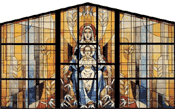 Above the organ in the choir loft, a beautiful stained glass window was installed in March of 1992. The design and installation were completed by Oakwood Esser Studios of Oconomowoc, and features Mary, the Mother of Jesus and patroness of our parish, presenting Jesus to the world as a reminder to parishioners that we, through our daily lives, are also to present Jesus to the world.
Above the organ in the choir loft, a beautiful stained glass window was installed in March of 1992. The design and installation were completed by Oakwood Esser Studios of Oconomowoc, and features Mary, the Mother of Jesus and patroness of our parish, presenting Jesus to the world as a reminder to parishioners that we, through our daily lives, are also to present Jesus to the world.
The lights in the church, school, and parish center seemed always to be burning, evidence of St. Mary's numerous religious, educational, business, social and recreational programs serving more than 2500 families, an 800-family growth in 10 years. To minister to this veritible city-in-itself, Father Barbian attracted a staff devoted to a "common vision," as he called it. "We are a church of people, not buildings. We are in the people business. We must always keep in mind that we are in the people business."
The staff's main thrust was spiritual ministry. It is sufficient to say here that "service" is the hallmark of this group, that ranges from clergy to a corps of volunteers who served as Monday-Thursday evening receptionists at the parish office. Father Barbian insisted that his staff, working with the Parish Council, focus on the needs of the parish as a whole, not on separate kingdoms. This staff reflected the trend of the future: greater reliance on lay ministers and lay leadership to enable the clergy to fulfill their primary, spiritual vocation. To assist our priests in the spiritual sphere, a permanent deacon was added in 1984, and a lay pastoral minister in 1991.
During Father Barbian's pastorate, St. Mary inaugurated a host of liturgical and support programs that marked it as a model parish. The weekly church bulletin read like a litany of events with commendable broad scope. These included: first Saturday devotions to Mary, our patronness, and other Marian celebrations; the annual Holy Hill pilgrimage; weekly Masses for all school children; an annual Mass for the bereaved; "Rainbow," a support program for counseling children from families disrupted by divorce or death; the Christian Family Movement (CFM); the annual evening for married couples; a designated Family Life month (November); the administration of FOCCUS, a pre-marital inventory, by married couples to engaged couples; the Parish Mission; the Ministry of Care and Hope for the bereaved; vesper services in Lent and Advent; the annual Day of Discipleship; a Youth Rally sponsored by district parishes; a cantor program; morning prayer services; special holiday liturgies at Thanksgiving, July 4, Memorial Day, Labor Day; the RCIA program; a seasonal "call-back" program before Lent and Advent for public school children; reconciliation and witness talks.
New choirs were formed to help make every liturgy special. In addition to the long-standing Mixed Choir and the Harmony Choir, the Resurrection Choir sang for funeral Masses; Godsong; and the Spirit Choir, composed of younger parish members. A music advisory committee was formed to assist and coordinate these choirs.
Father Barbian insisted that St. Mary's programs be rooted in prayer and lead to action, addressing the issues of Christian formation, equality and justice.
Moreover, St. Mary looked beyond parish boundaries through an outreach program that financially assisted deserving organizations in the Greater Milwaukee area and beyond. In this vein, part of the contributions to the sesquicentennial fund were earmarked for outreach projects. Another manifestation of outreach was the annual Christmastime "Circle of Love," which collected gifts for needy families inside and outside of the parish.
The periodic interchange with our sister parish, St. Matthew (25th and Scott Streets) made our council and parishioners better acquainted with the challenges of a metropolitan Milwaukee church. St. Mary supported "Walking Together," a multi-parish project that plans to identify and respond to needed community improvements.
Academically, our grade school students received a top level education. A kindergarten was added in 1982, enlarging the scope of Catholic education for our children. Attesting to the quality of education here, school enrollment was over-subscribed.
Shortly before Father Barbian's arrival, major building projects — the extensive remodeling of the church, a school addition, and the erection of the Community Center — were virtually completed. But other improvements and refinements continued to take place.
Parish records were computerized, business desks and typewriters updated, VCR equipment added. In the school, all upper wing and cafeteria windows were replaced in the interest of heat economy and appearance. Stained glass windows and a new organ were added to the church through sesquicentennial donations from parishioners.
To Father Barbian, environment was a sign of "caring." "If it's broken, fix it; if it can be improved, improve it," his actions say. "Keep up with the times." The foregoing physical improvements reflected Father Barbian's love of beauty and order — keeping things fit.
Changing times, however, brought an end to an association dating back to the mid-1800s. The reduction here in 1991 from three priests to two dictated that St. Mary relinquish its mission church, Holy Assumption in St. Martins. Holy Assumption became affiliated with nearby Sacred Hearts of Jesus and Mary, a geographically logical alliance.
Obviously, the developments of those 10 years were more than the handiwork of one man. But they were the apt reflection of his skill as a motivator. Father Barbian earned the mark of a man who gets others to say "I'll do it," and to share his belief that St. Mary was not just a parish, nor a church, nor a school, but the lively, dedicated, Christ-filled faith community envisioned by Vatican II.
1993
The year 1993 marked a time of change at St. Mary as we said farewell to pastor Rev. Leonard M. Barbian, who had served as our leader for almost 11 years. His next assignment was to serve as the executive secretary for the Priest Personnel Board of the Archdiocese. Father Leonard was remembered for his trademark corny jokes, homilies that carried messages in groups of threes and his strong support of our school. His ministry here was marked with uniting the parish. He also proclaimed that the gym was not a gym but a "Community Centre."
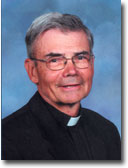 Rev. Art Heinze 1993 - 2005 |
Succeeding Father Leonard was Rev. Arthur G. Heinze, who came to us after serving as vice rector at St. Francis Seminary. Father Art arrived June 1 and we were quickly reminded of the goodness of God. Father Art's deep love of the sacraments, combined with his ability to "teach" as he broke open Scripture for his homilies, was a wonderful gift to be taken in by all. We also discovered that our pastor was a diehard Milwaukee Brewers fan - regardless of the team's woeful win/loss record -- and an avid bicyclist.
There were 38 graduates in the St. Mary 8th grade graduation class of 1993. The idea for monthly Youth Mass was introduced by Youth Minister Tim Winters in December 1993. This Mass, planned by and for the youth of our parish and their friends, was held at 6 p.m. on Sunday in the church. It soon developed a loyal following.
In January 1994, familiar weekend help-out and noted moral theology expert Father Bryan Massingale was the keynote speaker at our annual Day of Discipleship. Father Bryan's regular job was vice rector of St. Francis Seminary, but he had become a nationally known speaker and presenter. We were happy he accepted our offer to enrich us. We filled the Community Centre on a cold Saturday morning to listen and grow in faith.
St. Mary student Dawn Janiszewski initiated a 1.5-mile walkathon in February 1994 to raise money for cancer research, demonstrating our school's ability to teach the Gospel message of service.
Arise and Walk was the theme of the parish mission in March 1994. That spring, we also nurtured 16 RCIA candidates.
Father James Brady, our associate pastor, assumed the leadership role in our parish's Hope Offered Through Shared Ecumenical Action (HOSEA) group, an organization of Catholic and Lutheran churches working on social justice issues in our immediate communities.
Tom Kelm was hired in August 1994 as head custodian to succeed Dick Witterman who passed away.
The Archdiocese celebrated its 150th anniversary in 1994 and the bishops pledged to visit every parish in the diocese during the year. Archbishop Rembert Weakland presided at liturgy on a warm Sunday in July, and Auxiliary Bishop Richard Sklba visited the summer school of religion program that same summer, delighting the children with his keen interest in their studies.
The Altar Society raised $4,300 from its annual attic and bake sale in 1994, while the Spring Luncheon brought in $6,700.
By this time, Market Day, a fundraising activity that generates money for the school, was becoming popular with parishioners who stocked their freezers, refrigerators and kitchen cupboards with tasty, fresh, frozen and prepared foods. To be successful, Market Day relied on faithful volunteers from within the parish to organize the order taking and distribution of food on pick-up day.
The Women's Retreat Movement began in the winter of 1994. Mary Matestic and Carol Sullivan facilitated a retreat for 50 women who gathered at the Franciscan Retreat Center in Burlington, WI for soulful refreshment. Anne Morrow Lindbergh's time honored book, A Gift from the Sea, provided a peaceful resource for busy women who longed for quiet and the presence of God in a retreat setting. In 2001, the retreat moved to the Siena Center in Racine and it continues to grow and draw women who long to come to the quiet of Christ's heart for peace. The weekend retreat occurs annually in the autumn of the year.
In late winter 1994, Betty Alvey, a member of our Social Concerns Committee, received the U. S. Mayors' End Hunger Award for her work in the community.
1995
In January 1995, Father Art accepted the request to speak at the Day of Discipleship, our one day that is dedicated to ongoing Christian formation for adults. His topic was Sacramental Health Care: Anointing of the Sick.
Three hundred students were enrolled in grades 1- 8 for the summer school of religion in the summer of 1995. The students in the 2nd grade baked bread as part of their preparation for First Holy Communion.
Parenting with Purpose sessions were held on the first Mondays in November 1995, another example our parish fulfilling its mission to serve and be inclusive.
The Evangelization Committee, eager to invite all who have left the church or have been alienated for whatever reason, started the Lighthouse Listening sessions. These non-judgmental sessions consisted of one or two committee members who would wait patiently for someone to arrive and then simply listen to the story of the person who came to the session.In February 1995, Deacon Joe Dahlen retired from active ministry as an ordained deacon after nine years of service as our deacon.
In Spring 1995, the 7th graders put St. Mary School on the national map as they won the top honors in the National Engineers Week Future City competition. The team of Ryan Kukor, Craig Roush and Todd Wallschlaeger built the winning entry. They made the trip to Washington, D. C. to proudly represent our school and community.
June 1995 marked the arrival of a new associate, Rev. Greg Greiten. In his second parish assignment since ordination, Father Greg brought a new dimension to the pastoral team. He was especially helpful in the office with his proven computer skills. Like Father Art, Father Greg liked two-wheeled vehicles, too, but preferred his with motors. In a published interview in the parish newsletter, he was asked if someday he would own a Harley Davidson. His response was, "Sure, when I'm pastor."
January 1996 was a pivotal time for the parish as it embarked on a period of strategic planning, a much-needed effort to set a course for the future of the parish. A Strategic Planning team was appointed in February 1996 and it worked for the next two years developing strategies for the parish's spiritual and educational growth.
It should also be noted that January 1996 was the time when the Young at Heart group came alive. This hearty, life-loving group of people decided it was time to organize events and activities that would build community and provide avenues for fun. There were tours to take, plays to be seen, busses to be boarded, friends to be met, and meals to be enjoyed.
In April 1996, the Parish/School Endowment Fund was re-energized as a strategy to build a base of investment that would pay dividends in the future. The strategy was seen as a way to help manage the ever increasing costs to run the school and the parish.
Director of Family and Adult Ministry Daryl Olszewski left the parish in July 1996 to respond to the call to become a parish director in the archdiocese. Daryl was credited with the development and/or execution of many outstanding adult formation programs, including RCIA, Mathethai, the Men's Prayer Group and Day of Discipleship. He had been a contributing member of the team since 1987. A search committee was formed to find Daryl's replacement. In the fall of 1996, Sister Josephe Marie Flynn, SSND, arrived as his able successor.
The first "Royal Affair" fundraising auction and dinner was held Nov. 16, 1996, at the Tuckaway Country Club in Franklin. Parish members and friends donned their finest evening wear,and brought their check books and their willing hearts to the event, to support the Parish/School Endowment Fund. Friendly competition for several of the auction items pushed the bids higher and higher. The first event was so successful that it was sure to become a standing item on our parish annual calendar for years to come.
Moving from money to ministry, the Elizabeth Ministry began to take shape in 1996. Led by Peg Nugent, Ginger Rambo and Mary Matestic, this ministry was established to reach out to women anticipating a challenging birth and those desiring to become pregnant or those who had lost a child through childbirth or pregnancy. The ministry was so well conceived and executed that it was featured in the archdiocesan newspaper, the Catholic Herald, and also became a model for other parishes to emulate. The many volunteers eager to be part of this ministry added a welcoming dimension to all new babies in the parish.
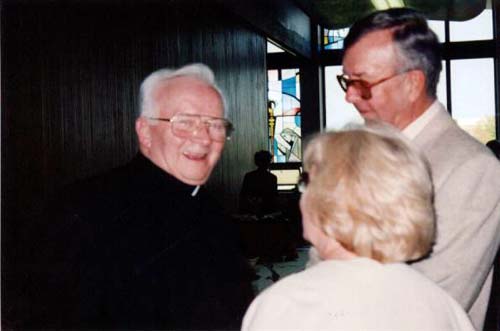 On June 21 and 22, 1997, the parish thanked Rev. James Brady for his 44 years of priesthood and helped him celebrate his new life stage-retirement. A wine and cheese social followed the 5 p.m. mass, and continental breakfast was served following the Sunday masses. We were grateful beyond words for the years that we were graced with this priest's special gifts, his friendship and his gentle spirit.
On June 21 and 22, 1997, the parish thanked Rev. James Brady for his 44 years of priesthood and helped him celebrate his new life stage-retirement. A wine and cheese social followed the 5 p.m. mass, and continental breakfast was served following the Sunday masses. We were grateful beyond words for the years that we were graced with this priest's special gifts, his friendship and his gentle spirit.
With the retirement of Father Brady, we have just two priests on staff so we're grateful for Father Andy Nelson, Father Mel Michalski and Father Dominic Caldognetto who help out. Father Andy and Father Mel are St. Francis Seminary teaching colleagues of Father Art. Father Dominic is a Xaverian Missionary priest.
More transitions followed for the parish in 1997 as school principal Sister Rene Kuban followed a call to move to another parish school. She was succeeded by Mary Ann Rudella, who brought more than 20 years of teaching and elementary school administration experience to the post. She previously was principal at All Saints Catholic Elementary School, and has taught grades 3 through 12 as well.
In the Spring of 1998, a clever fundraising idea for the school places Father Art on the pitching mound to toss out the ceremonial first pitch at a Brewers game. The stands are filled with a strong contingent from St. Mary, with $2 from every ticket going to support the technology needs of the school. Knowing Father Art, you can be sure he practiced his throw for weeks before he trotted out to the mound.
June signaled graduation time and in 1998 our parish school had 49 8th grade graduates and 46 kindergarten grads.
Later in 1998, long-time staff member Dorothy Damiano retired after serving the parish for 38 years. Dorothy's last assignment was that of business manager, where she contracted for critical parish services (remember the leaking roof?) but she served in so many other roles, many without titles. Besides being the glue that held the staff together with her thoughtful gestures and acts of kindness, she was a Eucharistic minister and member of many committees. It seemed that Dorothy was always there, helping with a meal, tidying up the office kitchen or assisting with a funeral or a special liturgy.
Barbara Searing joined the staff in October 1999 as director of Child Ministry, allowing long-time director Barb Schwartz to cut back on hours while continuing to direct part of the Child Ministry program in addition to coordinating the FOCCUS program for the engaged, as well as the stewardship of time and talent.
The annual bread exchange at the Thanksgiving Day liturgy was continuing strong in 1999, six years after it was launched by Father Art as a way to bring our large parish together. Bake or buy a bread, bring it to the table in the church with your name and phone number on it. After mass, you took home a different bread and called the person who brought it to say hello and wish them a happy Thanksgiving. Community building continues.
The St. Vincent de Paul Society coordinated another Francis Rainer Clean Up day in the Spring of 2000. This day brings out parish members who help clean up parts of the parish property, in memory of a deceased parish and St. Vincent de Paul Society member who untiringly picked up litter and debris from the property for years.
A new and exciting relationship with a parish in Haiti took root in June 2000 as St. Mary reached across the continents to touch the people of Our Lady of Perpetual Help in Latiboliere, Haiti. View more information about our Haiti Sister Parish ministry.
Continue Reading...
The 1800's
2000 to Today